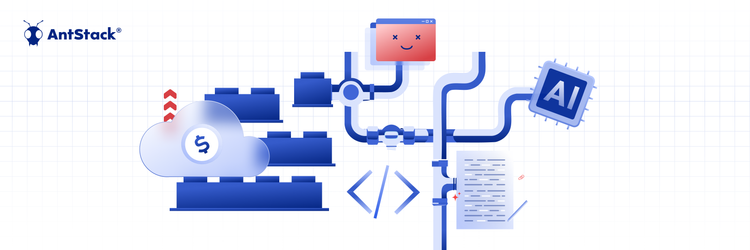Serverless computing is becoming increasingly popular. It continues to evolve significantly as cloud providers come up with better approaches for applications. The serverless deployment can offer many benefits for businesses looking to focus on their innovation without having to worry about the underlying architecture.
According to Forbes, nearly 30% of the physical servers are in a ‘comatose state’. This means that there are approximately 11 million servers across the world that are underutilized yet paid for. By opting for a traditional server infrastructure to meet sporadic demand, there is a good chance that you will add to this statistic. Servers sitting idle at data centers require investment just to keep the power on.
Switching to serverless helped organizations reduce spending on infrastructure freeing the budget for expenditure in other areas and generating overall business value. A study by the IDC found that switching to the serverless framework hosted by AWS can help a single organization have an average annual savings of up to $10.71 million.

Serverless Architecture Explained
Serverless Architecture is a model which allows users to build and run applications and services without having to manage the underlying infrastructure. The application still runs on servers, but the developers are not responsible for server management. Developers can write and deploy code but do not have to provision, scale or maintain servers to run applications, storage systems, and databases.
The serverless computing model provides backend services on a ‘pay-as-you-use’ basis. When a business takes its backend service from a serverless vendor, it is charged based on computation. Developers pay only for the services that they use.
Serverless cloud computing is also referred to as Functions as a Service or FaaS since developers use serverless architecture to work on specific functions. In serverless computing, functions are executed in the following manner:
- Developers write a function, typically meant to serve a specific need within the code.
- Developers define an event to trigger the cloud service provider to execute the function.
- The event gets triggered.
- The cloud provider checks if an instance of the function is already open. If not, it kickstarts a new instance of the function, and it gets executed.
- The user gets the result of the function in their application.
Benefits of Serverless Architecture
Cost: Cloud providers charge on a per-invocation basis. Businesses that use serverless cloud computing do not have to pay for unused servers or virtual machines.
Scalability: Serverless applications can scale up or down to accommodate user usage. Servers run when needed through the help of containers to run multiple instances of a function. Hence, serverless applications can handle a large number of requests coming from thousands of users.
Productivity: Developers using serverless architecture only have to worry about building and deploying the code without the overhead of having to manage servers. Businesses can stick to worrying about innovation and leave the infrastructure management to the cloud providers. Developers using the serverless model reported a 20% increase in efficiency, thus saving $280,500 just from increased IT and business productivity.
Decreased Latency: Since serverless applications are not hosted on an origin server, the code can run from anywhere. It can lower latency since the users’ requests do not have to travel to the origin server, ensuring there is a lower data transmission time. AWS offers higher resilience and security, ensuring a 71% decrease in unplanned outages. The cost of downtime has been estimated to cost businesses as much as $5.600 per minute. Some businesses have even reported that it has cost them over $100,000 per hour.
When To Use Serverless Architecture
Some cases where a serverless framework would be ideal for a business:
- The aim is to develop innovative and effective solutions without having the overhead of maintaining the infrastructure.
- There is a need to reduce development costs without compromising on quality.
- Applications that have an unpredictable server load.
- The apps are designed to be constantly changing.
- There is a need for automatic scaling up without getting involved in the backend complexities.
The Rise of the Serverless Cloud
The development of the serverless cloud started in 2014 when AWS first launched AWS Lambda. Following its success, Microsoft soon launched Azure Functions, and Google launched Cloud Functions.
The immense benefits of serverless architecture have made it a rising star in the cloud computing industry. Traditional methods are seeing a paradigm shift in the current era of the networking industry. Organizations looking to accelerate the delivery of high-quality applications are taking advantage of the serverless model to drive their digital transformation process.
Serverless Architecture Examples
Some examples of serverless applications in use are:
- Smart Devices and IoT
IoT devices involve short bursts of interaction involving real-time data exchange. IoT environments also handle unpredictable volumes of data with functionalities that are entirely event-based. The serverless framework is ideal for IoT environments as it allows you to connect the IoT gateway or hub to other elements of the IoT landscape.
- Event-based applications
Applications that heavily rely on user-triggered interactions and events are ideal for serverless deployment. E-commerce websites stand to benefit from serverless models for fetching product data, delivery information, and payment information. On-demand learning content providers and webinar hosts can also benefit from switching to serverless.

- Automated System Administration
Serverless computing can be used for internal applications, as well. Deloitte’s Cloud Managed Services product uses serverless computing to deliver scalable and optimized infrastructure support to its clients.
How Can Antstack Help You Go Serverless To Reduce Cost and Improve Bottom lines
AntStack aims to help businesses across the globe create applications and services, and scale their business offerings. As your entrusted partners, we will bring a team of serverless connoisseurs to help businesses tackle challenges.
We first identify your business objectives and recognize your requirements. Once this is clear, we will find a technology stack that is best suited for serverless deployment. We offer development plans and help you set up the system architecture design. Antstack will help you build functions on your website and deploy them by helping you set up a data storage environment on the Amazon AWS environment.










